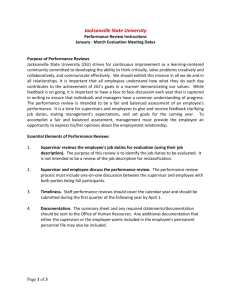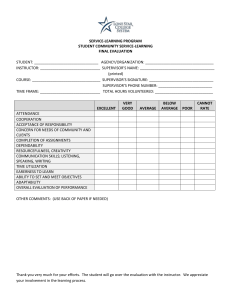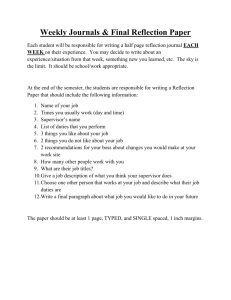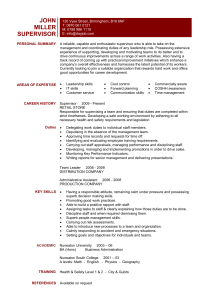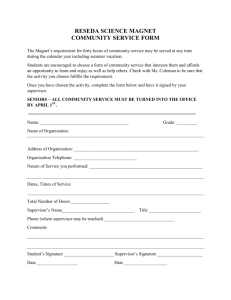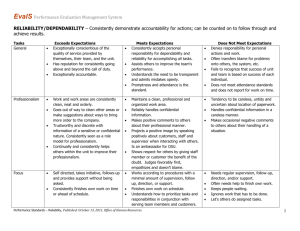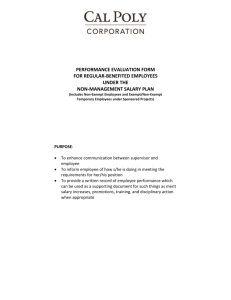performance-review-instructions
advertisement
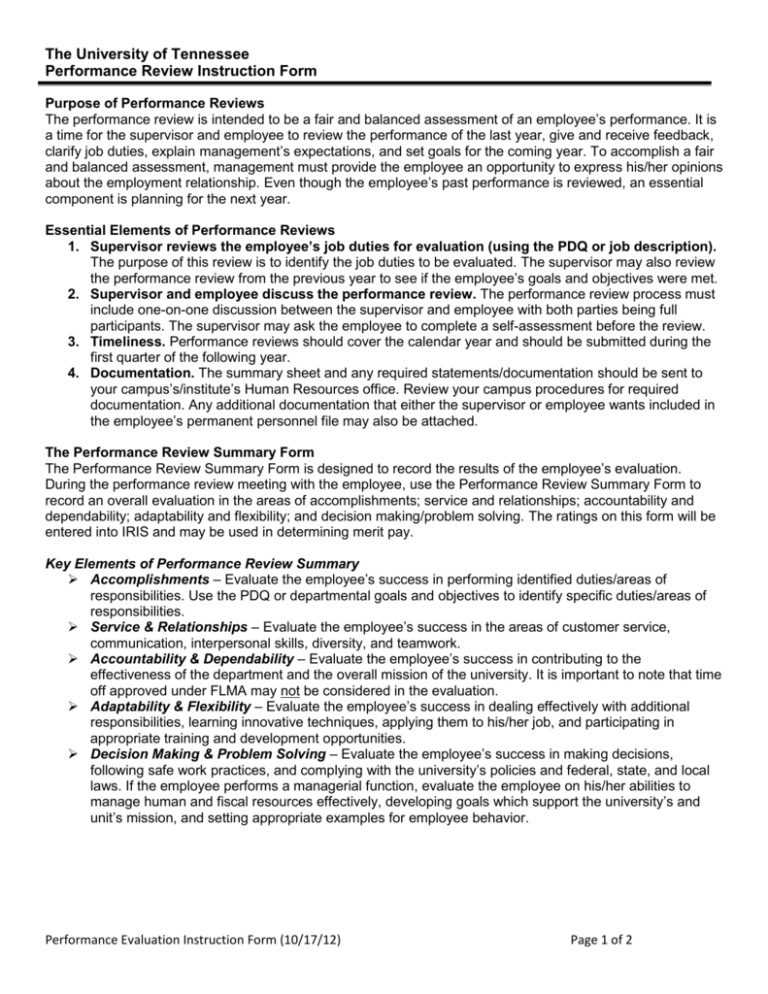
The University of Tennessee Performance Review Instruction Form Purpose of Performance Reviews The performance review is intended to be a fair and balanced assessment of an employee’s performance. It is a time for the supervisor and employee to review the performance of the last year, give and receive feedback, clarify job duties, explain management’s expectations, and set goals for the coming year. To accomplish a fair and balanced assessment, management must provide the employee an opportunity to express his/her opinions about the employment relationship. Even though the employee’s past performance is reviewed, an essential component is planning for the next year. Essential Elements of Performance Reviews 1. Supervisor reviews the employee’s job duties for evaluation (using the PDQ or job description). The purpose of this review is to identify the job duties to be evaluated. The supervisor may also review the performance review from the previous year to see if the employee’s goals and objectives were met. 2. Supervisor and employee discuss the performance review. The performance review process must include one-on-one discussion between the supervisor and employee with both parties being full participants. The supervisor may ask the employee to complete a self-assessment before the review. 3. Timeliness. Performance reviews should cover the calendar year and should be submitted during the first quarter of the following year. 4. Documentation. The summary sheet and any required statements/documentation should be sent to your campus’s/institute’s Human Resources office. Review your campus procedures for required documentation. Any additional documentation that either the supervisor or employee wants included in the employee’s permanent personnel file may also be attached. The Performance Review Summary Form The Performance Review Summary Form is designed to record the results of the employee’s evaluation. During the performance review meeting with the employee, use the Performance Review Summary Form to record an overall evaluation in the areas of accomplishments; service and relationships; accountability and dependability; adaptability and flexibility; and decision making/problem solving. The ratings on this form will be entered into IRIS and may be used in determining merit pay. Key Elements of Performance Review Summary Accomplishments – Evaluate the employee’s success in performing identified duties/areas of responsibilities. Use the PDQ or departmental goals and objectives to identify specific duties/areas of responsibilities. Service & Relationships – Evaluate the employee’s success in the areas of customer service, communication, interpersonal skills, diversity, and teamwork. Accountability & Dependability – Evaluate the employee’s success in contributing to the effectiveness of the department and the overall mission of the university. It is important to note that time off approved under FLMA may not be considered in the evaluation. Adaptability & Flexibility – Evaluate the employee’s success in dealing effectively with additional responsibilities, learning innovative techniques, applying them to his/her job, and participating in appropriate training and development opportunities. Decision Making & Problem Solving – Evaluate the employee’s success in making decisions, following safe work practices, and complying with the university’s policies and federal, state, and local laws. If the employee performs a managerial function, evaluate the employee on his/her abilities to manage human and fiscal resources effectively, developing goals which support the university’s and unit’s mission, and setting appropriate examples for employee behavior. Performance Evaluation Instruction Form (10/17/12) Page 1 of 2 The University of Tennessee Performance Review Instruction Form Ratings Expectations should be specific, measurable, attainable, realistic, and timely. An employee should be evaluated based on how well he/she has met the known expectations of his/her position. Evaluate the employee using the following options: Consistently Exceeds Achieves Expectations Example: Employee consistently completes tasks early or on time and will consistently seek ways to help others complete tasks and/or accepts additional tasks. Fully Achieves & Occasionally Exceeds Expectations Example: Employee consistently completes tasks early or on time and will occasionally seek ways to help others complete tasks and/or accepts additional tasks. Fully Achieves Expectations Example: Employee consistently completes tasks on time or in a timely manner with no intervention. Sometimes Achieves Expectations Example: Employee sometimes does/sometimes does not complete tasks on time and may often have to be reminded to complete the tasks. Rarely Achieves Expectations Example: Employee rarely completes tasks on time. Other Forms and Retention of Performance Review Form Please review your campus’s/institute’s procedures for any additional detailed forms necessary to complete the performance review. These procedures should also include retention requirements. Appeals If the employee disagrees with the evaluation, he/she should discuss his/her concerns with the supervisor. Supervisors may click on this link for access to forms and other information. On-line performance review courses may be accessed by going to the Employee and Organizational Development website. Questions Questions about performance reviews may be forwarded to your local Human Resources office. Attending a training session on how to conduct an effective performance review may be scheduled by contacting your local Human Resources-Training office: Chattanooga Health Science Center (Memphis) Knoxville Area Martin Space Institute Performance Evaluation Instruction Form (10/17/12) (423) 425-4221 (901) 448-5600 (865) 974-6657 (731) 881-7845 (931) 393-7226 Page 2 of 2
